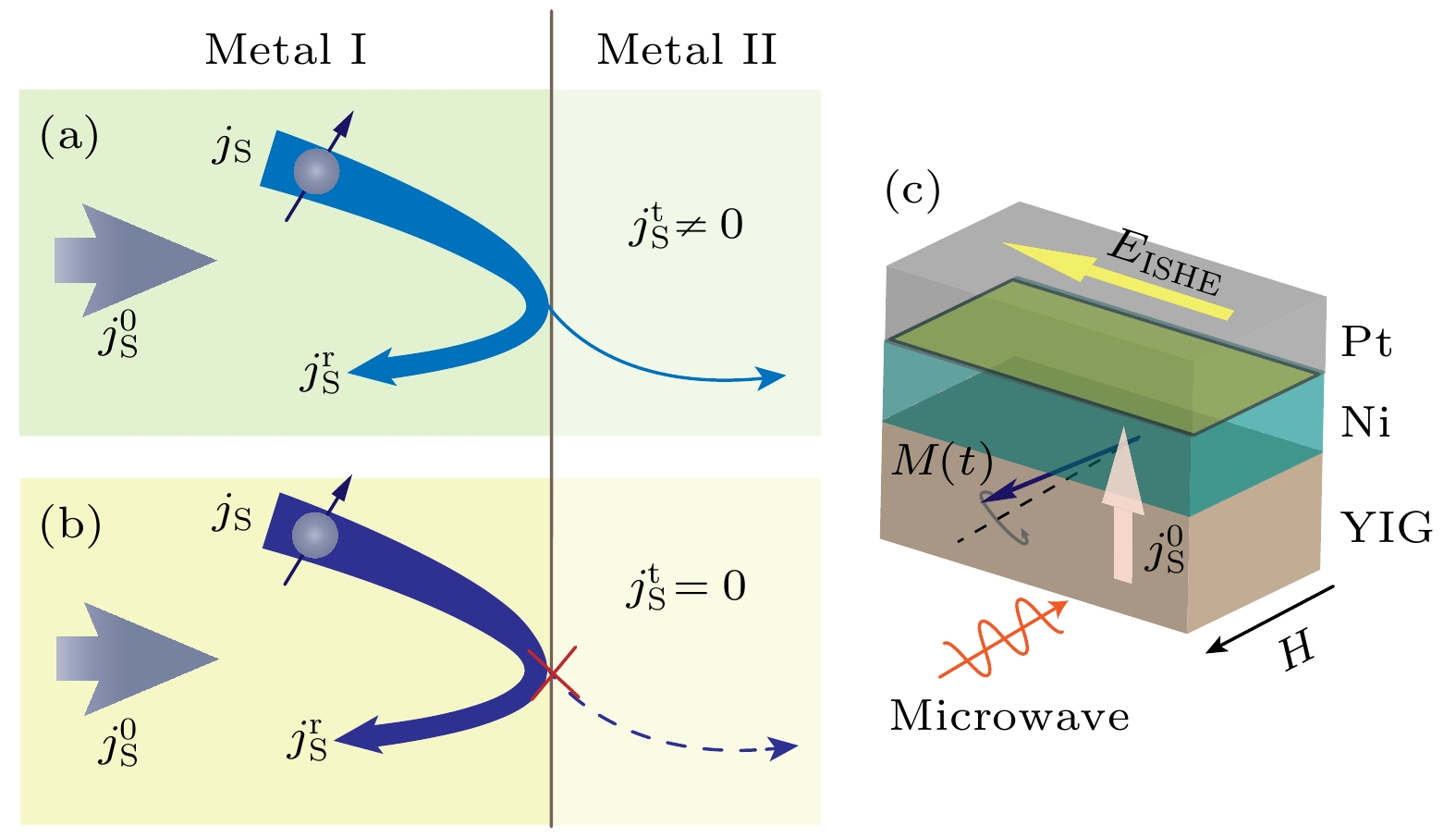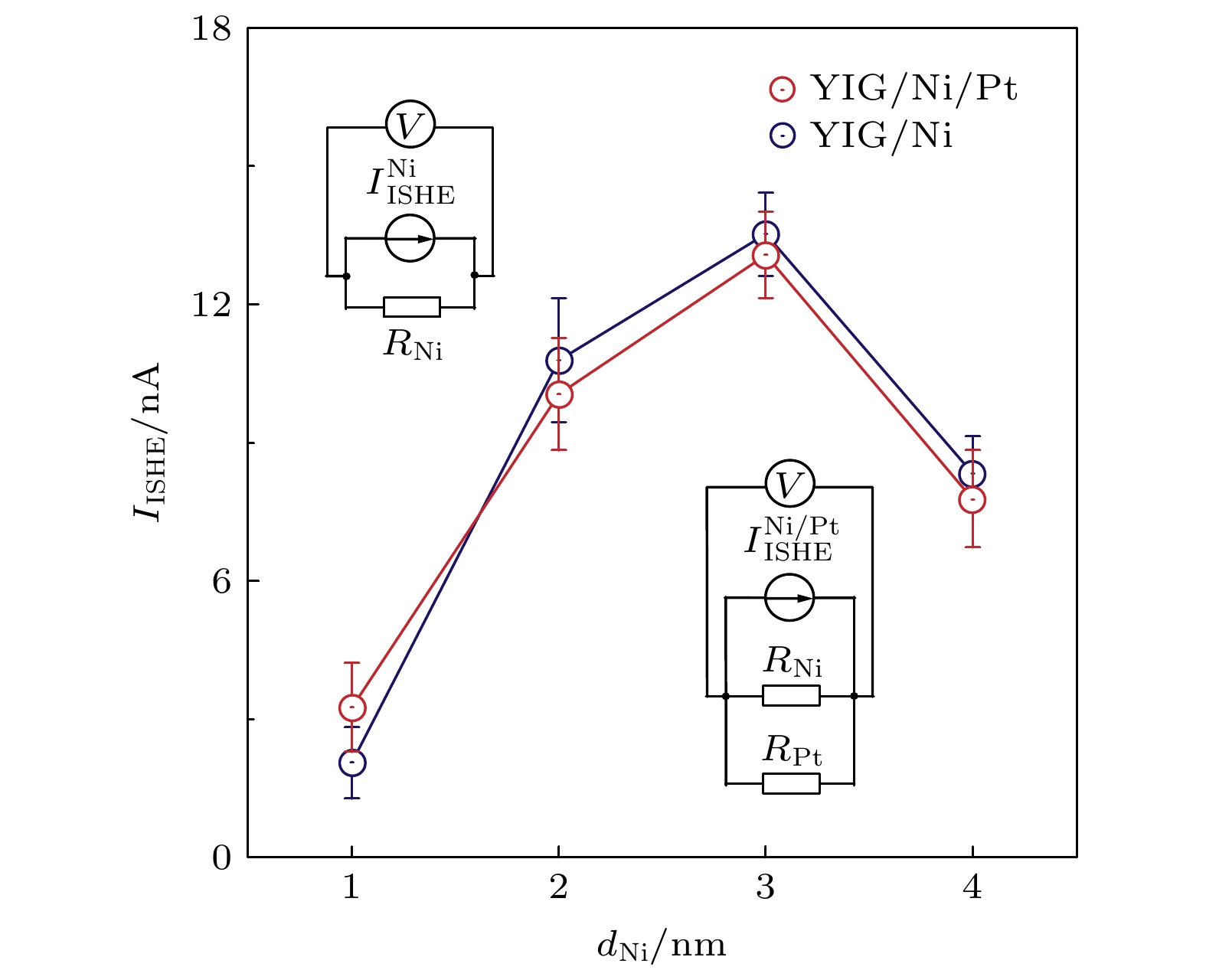-
相比于电荷流的高功耗, 自旋流可以高效地传输能量与信息的同时避免焦耳热的产生, 因此基于自旋流的电子器件成为未来电子信息器件研发的重要方向之一. 自旋流及其输运现象的相关研究是自旋电子学器件的开发基础. 本文着眼于铁磁金属镍(Ni)与非磁重金属(Pt)构建的异质结结构, 研究了异质结界面的自旋输运特性, 发现其对扩散自旋流的全阻塞效应. 本工作以基于钇铁石榴石(yttrium iron garnet, YIG)的YIG/Ni/Pt三层器件开展, 采用自旋泵浦技术激发扩散自旋流注入到镍中, 同时检测与分析器件中的逆自旋霍尔电压, 并与YIG/Ni双层器件中的信号进行对比分析. 结果证明YIG/Ni/Pt三层器件中的铂金属层仅起分流作用而对逆自旋霍尔电流无贡献, 即镍层中的扩散自旋流被阻塞于Ni/Pt异质结界面. 本工作加深了对界面处自旋流输运的认识, 铁磁性金属/非磁重金属自旋流阻塞界面的发现也为自旋电子器件的设计及新功能开发提供了新的思路与手段.Spin current, the flow of spin angular momentum, can carry and transport energy and/or information without generating Joule heating, which makes spin-based devices become one of the potential aspects for the next-generation information processing devices. It is important to investigate the generation, transport, and detection of spins for developing spin-based devices, in which the spin transport and its related phenomena attract ongoing interest due to the complex interactions between spins and condensed matter system. Here, spin transport phenomenon is studied at a heterojunction consisting of ferromagnetic metal nickel and nonmagnetic heavy metal platinum, where transport spins are found to be totally blocked. Two series of spin-pumping devices, i.e. the yttrium iron garnet (YIG)/Ni/Pt trilayer devices and the contrastive YIG/Ni bilayer devices, are made in this work. The YIG serves as a substrate and spin-pump layer, on which nickel film and platinum film are deposited by a dc magnetron sputtering system. Spin currents are generated from YIG and injected into nickel layers by spin pumping technology. The voltage signals corresponding to the inverse spin Hall effect are detected and analyzed comparatively for both YIG/Ni/Pt trilayer device and YIG/Ni bilayer device. It is found that the platinum layers in YIG/Ni/Pt trilayer devices act only as charge current shunting but do not contribute to the spin-charge conversion. This implies that the spin current cannot transport through the Ni/Pt interface even when the nickel layer is as thin as 1 nm, in other words, the spin current is blocked at the Ni/Pt interface. Our result proposes a heterojunction that can block transport spins totally, which has never been discussed before, and the present study may expand the views and promote the development of spin-based devices.
-
Keywords:
- spin current /
- heterojunction interface /
- spin blocking /
- spin pumping
[1] Flatte M E 2007 IEEE Trans. Electron Devices 54 907
 Google Scholar
Google Scholar
[2] Brataas A, Kent A D, Ohno H 2012 Nat. Mater. 11 372
 Google Scholar
Google Scholar
[3] Wolf S A, Awschalom D D, Buhrman R A, Daughton J M, von Molnar S, Roukes M L, Chtchelkanova A Y, Treger D M 2001 Science 294 1488
 Google Scholar
Google Scholar
[4] Matsuo M, Ieda J, Saitoh E, Maekawa S 2011 Phys. Rev. Lett. 106 076601
 Google Scholar
Google Scholar
[5] Maekawa S, Adachi H, Uchida K-i, Ieda J i, Saitoh E 2013 J. Phys. Soc. Jpn. 82 102002
 Google Scholar
Google Scholar
[6] Takahashi S, Maekawa S 2008 Sci. Technol. Adv. Mater. 9 014105
 Google Scholar
Google Scholar
[7] Hirsch J E 1999 Phys. Rev. Lett. 83 1834
 Google Scholar
Google Scholar
[8] Sinova J, Valenzuela S O, Wunderlich J, Back C H, Jungwirth T 2015 Rev. Mod. Phys. 87 1213
 Google Scholar
Google Scholar
[9] Shen J, Feng Z, Xu P, Hou D, Gao Y, Jin X 2021 Phys. Rev. Lett. 126 197201
 Google Scholar
Google Scholar
[10] Chen X, Shi S, Shi G, Fan X, Song C, Zhou X, Bai H, Liao L, Zhou Y, Zhang H, Li A, Chen Y, Han X, Jiang S, Zhu Z, Wu H, Wang X, Xue D, Yang H, Pan F 2021 Nat. Mater. 20 800
 Google Scholar
Google Scholar
[11] Okamoto S 2016 Phys. Rev. B 93 064421
 Google Scholar
Google Scholar
[12] Liu M, Sha R, Wang M, Peng Y, Zhang Z, Zou A, Xu Y, Guo F, Qiu Z 2021 J. Phys. D Appl. Phys. 54 155001
 Google Scholar
Google Scholar
[13] Zhu L, Ralph D C, Buhrman R A 2019 Phys. Rev. Lett. 123 057203
 Google Scholar
Google Scholar
[14] Ong T T, Nagaosa N 2018 Phys. Rev. Lett. 121 066603
 Google Scholar
Google Scholar
[15] Wimmer T, Althammer M, Liensberger L, Vlietstra N, Geprags S, Weiler M, Gross R, Huebl H 2019 Phys. Rev. Lett. 123 257201
 Google Scholar
Google Scholar
[16] Kroemer H 2001 Rev. Mod. Phys. 73 783
 Google Scholar
Google Scholar
[17] Kurt H, Loloee R, Eid K, Pratt W P, Bass J 2002 Appl. Phys. Lett. 81 4787
 Google Scholar
Google Scholar
[18] Nguyen H Y T, Pratt W P, Bass J 2014 J. Magn. Magn. Mater. 361 30
 Google Scholar
Google Scholar
[19] Rojas-Sanchez J C, Reyren N, Laczkowski P, Savero W, Attane J P, Deranlot C, Jamet M, George J M, Vila L, Jaffres H 2014 Phys. Rev. Lett. 112 106602
 Google Scholar
Google Scholar
[20] Chen K, Zhang S 2015 Phys. Rev. Lett. 114 126602
 Google Scholar
Google Scholar
[21] Hoffmann A 2007 Phys. Status Solidi C 4 4236
 Google Scholar
Google Scholar
[22] Yang F, Chris Hammel P 2018 J. Phys. D Appl. Phys. 51 253001
 Google Scholar
Google Scholar
[23] Ando K, Kajiwara Y, Takahashi S, Maekawa S, Takemoto K, Takatsu M, Saitoh E 2008 Phys. Rev. B 78 014413
 Google Scholar
Google Scholar
[24] Ando K, Takahashi S, Ieda J, Kajiwara Y, Nakayama H, Yoshino T, Harii K, Fujikawa Y, Matsuo M, Maekawa S, Saitoh E 2011 J. Appl. Phys. 109 103913
 Google Scholar
Google Scholar
[25] Saitoh E, Ueda M, Miyajima H, Tatara G 2006 Appl. Phys. Lett. 88 182509
 Google Scholar
Google Scholar
[26] Qiu Z, Li J, Hou D, Arenholz E, N'Diaye A T, Tan A, Uchida K, Sato K, Okamoto S, Tserkovnyak Y, Qiu Z Q, Saitoh E 2016 Nat. Commun. 7 12670
 Google Scholar
Google Scholar
[27] Sha R, Liu Q, Wang M, Liu M, Peng Y, Zhang Z, Zou A, Xu Y, Jiang X, Qiu Z 2021 Phys. Rev. B 103 024432
 Google Scholar
Google Scholar
[28] Qiu Z, An T, Uchida K, Hou D, Shiomi Y, Fujikawa Y, Saitoh E 2013 Appl. Phys. Lett. 103 182404
 Google Scholar
Google Scholar
[29] Du C, Wang H, Yang F, Hammel P C 2014 Phys. Rev. B 90 140407
 Google Scholar
Google Scholar
[30] Nakayama H, Ando K, Harii K, Yoshino T, Takahashi R, Kajiwara Y, Uchida K, Fujikawa Y, Saitoh E 2012 Phys. Rev. B 85 144408
 Google Scholar
Google Scholar
-
图 2 (a) 自旋泵浦实验设置与YIG/Ni/Pt三层器件及YIG/Ni双层器件的结构示意图; (b) 多层器件的典型微波吸收谱; (c) YIG/Ni(3 nm)/Pt三层及YIG/Ni(3 nm)双层器件的电压信号V与外磁场H的依存关系图
Fig. 2. (a) Illustration of experimental spin pumping set-up of YIG/Ni/Pt trilayer and YIG/Ni bilayer devices; (b) the typical microwave absorption spectrum; (c) the external magnetic field H dependences of the voltage signals V for the YIG/Ni(3 nm)/Pt trilayer and YIG/Ni(3 nm) bilayer devices.
图 3 不同Ni层厚度dNi的YIG/Ni/Pt三层 (a) 及YIG/Ni双层器件 (b) 的电压信号V与外磁场H的关系; (c) 逆自旋霍尔电压VISHE 与Ni层厚度dNi的关系(插图为两种器件的横向电阻R与Ni层厚度dNi的关系)
Fig. 3. The external magnetic field H dependences of the voltage signals V for the YIG/Ni/Pt trilayer devices (a) and the YIG/Ni bilayer devices (b) with different nickel layer thicknesses dNi; (c) the nickel layer thickness dNi dependences of the inverse spin Hall voltage signal VISHE for the two series of devices (the inset shows the nickel layer thickness dNi dependences of the transverse resistances R).
图 4 YIG/Ni/Pt三层及YIG/Ni双层器件中逆自旋霍尔电流 IISHE与Ni层厚度dNi的依存关系图(插图是两种器件中逆自旋霍尔效应测量的等效电路图)
Fig. 4. The nickel layer thicknesses dNi dependences of the inverse spin Hall current IISHE for the YIG/Ni/Pt trilayer devices and the YIG/Ni bilayer devices (the insets are the equivalent circuits for inverse spin Hall measurement for the two series of devices).
-
[1] Flatte M E 2007 IEEE Trans. Electron Devices 54 907
 Google Scholar
Google Scholar
[2] Brataas A, Kent A D, Ohno H 2012 Nat. Mater. 11 372
 Google Scholar
Google Scholar
[3] Wolf S A, Awschalom D D, Buhrman R A, Daughton J M, von Molnar S, Roukes M L, Chtchelkanova A Y, Treger D M 2001 Science 294 1488
 Google Scholar
Google Scholar
[4] Matsuo M, Ieda J, Saitoh E, Maekawa S 2011 Phys. Rev. Lett. 106 076601
 Google Scholar
Google Scholar
[5] Maekawa S, Adachi H, Uchida K-i, Ieda J i, Saitoh E 2013 J. Phys. Soc. Jpn. 82 102002
 Google Scholar
Google Scholar
[6] Takahashi S, Maekawa S 2008 Sci. Technol. Adv. Mater. 9 014105
 Google Scholar
Google Scholar
[7] Hirsch J E 1999 Phys. Rev. Lett. 83 1834
 Google Scholar
Google Scholar
[8] Sinova J, Valenzuela S O, Wunderlich J, Back C H, Jungwirth T 2015 Rev. Mod. Phys. 87 1213
 Google Scholar
Google Scholar
[9] Shen J, Feng Z, Xu P, Hou D, Gao Y, Jin X 2021 Phys. Rev. Lett. 126 197201
 Google Scholar
Google Scholar
[10] Chen X, Shi S, Shi G, Fan X, Song C, Zhou X, Bai H, Liao L, Zhou Y, Zhang H, Li A, Chen Y, Han X, Jiang S, Zhu Z, Wu H, Wang X, Xue D, Yang H, Pan F 2021 Nat. Mater. 20 800
 Google Scholar
Google Scholar
[11] Okamoto S 2016 Phys. Rev. B 93 064421
 Google Scholar
Google Scholar
[12] Liu M, Sha R, Wang M, Peng Y, Zhang Z, Zou A, Xu Y, Guo F, Qiu Z 2021 J. Phys. D Appl. Phys. 54 155001
 Google Scholar
Google Scholar
[13] Zhu L, Ralph D C, Buhrman R A 2019 Phys. Rev. Lett. 123 057203
 Google Scholar
Google Scholar
[14] Ong T T, Nagaosa N 2018 Phys. Rev. Lett. 121 066603
 Google Scholar
Google Scholar
[15] Wimmer T, Althammer M, Liensberger L, Vlietstra N, Geprags S, Weiler M, Gross R, Huebl H 2019 Phys. Rev. Lett. 123 257201
 Google Scholar
Google Scholar
[16] Kroemer H 2001 Rev. Mod. Phys. 73 783
 Google Scholar
Google Scholar
[17] Kurt H, Loloee R, Eid K, Pratt W P, Bass J 2002 Appl. Phys. Lett. 81 4787
 Google Scholar
Google Scholar
[18] Nguyen H Y T, Pratt W P, Bass J 2014 J. Magn. Magn. Mater. 361 30
 Google Scholar
Google Scholar
[19] Rojas-Sanchez J C, Reyren N, Laczkowski P, Savero W, Attane J P, Deranlot C, Jamet M, George J M, Vila L, Jaffres H 2014 Phys. Rev. Lett. 112 106602
 Google Scholar
Google Scholar
[20] Chen K, Zhang S 2015 Phys. Rev. Lett. 114 126602
 Google Scholar
Google Scholar
[21] Hoffmann A 2007 Phys. Status Solidi C 4 4236
 Google Scholar
Google Scholar
[22] Yang F, Chris Hammel P 2018 J. Phys. D Appl. Phys. 51 253001
 Google Scholar
Google Scholar
[23] Ando K, Kajiwara Y, Takahashi S, Maekawa S, Takemoto K, Takatsu M, Saitoh E 2008 Phys. Rev. B 78 014413
 Google Scholar
Google Scholar
[24] Ando K, Takahashi S, Ieda J, Kajiwara Y, Nakayama H, Yoshino T, Harii K, Fujikawa Y, Matsuo M, Maekawa S, Saitoh E 2011 J. Appl. Phys. 109 103913
 Google Scholar
Google Scholar
[25] Saitoh E, Ueda M, Miyajima H, Tatara G 2006 Appl. Phys. Lett. 88 182509
 Google Scholar
Google Scholar
[26] Qiu Z, Li J, Hou D, Arenholz E, N'Diaye A T, Tan A, Uchida K, Sato K, Okamoto S, Tserkovnyak Y, Qiu Z Q, Saitoh E 2016 Nat. Commun. 7 12670
 Google Scholar
Google Scholar
[27] Sha R, Liu Q, Wang M, Liu M, Peng Y, Zhang Z, Zou A, Xu Y, Jiang X, Qiu Z 2021 Phys. Rev. B 103 024432
 Google Scholar
Google Scholar
[28] Qiu Z, An T, Uchida K, Hou D, Shiomi Y, Fujikawa Y, Saitoh E 2013 Appl. Phys. Lett. 103 182404
 Google Scholar
Google Scholar
[29] Du C, Wang H, Yang F, Hammel P C 2014 Phys. Rev. B 90 140407
 Google Scholar
Google Scholar
[30] Nakayama H, Ando K, Harii K, Yoshino T, Takahashi R, Kajiwara Y, Uchida K, Fujikawa Y, Saitoh E 2012 Phys. Rev. B 85 144408
 Google Scholar
Google Scholar
计量
- 文章访问数: 5497
- PDF下载量: 156
- 被引次数: 0














 下载:
下载:



